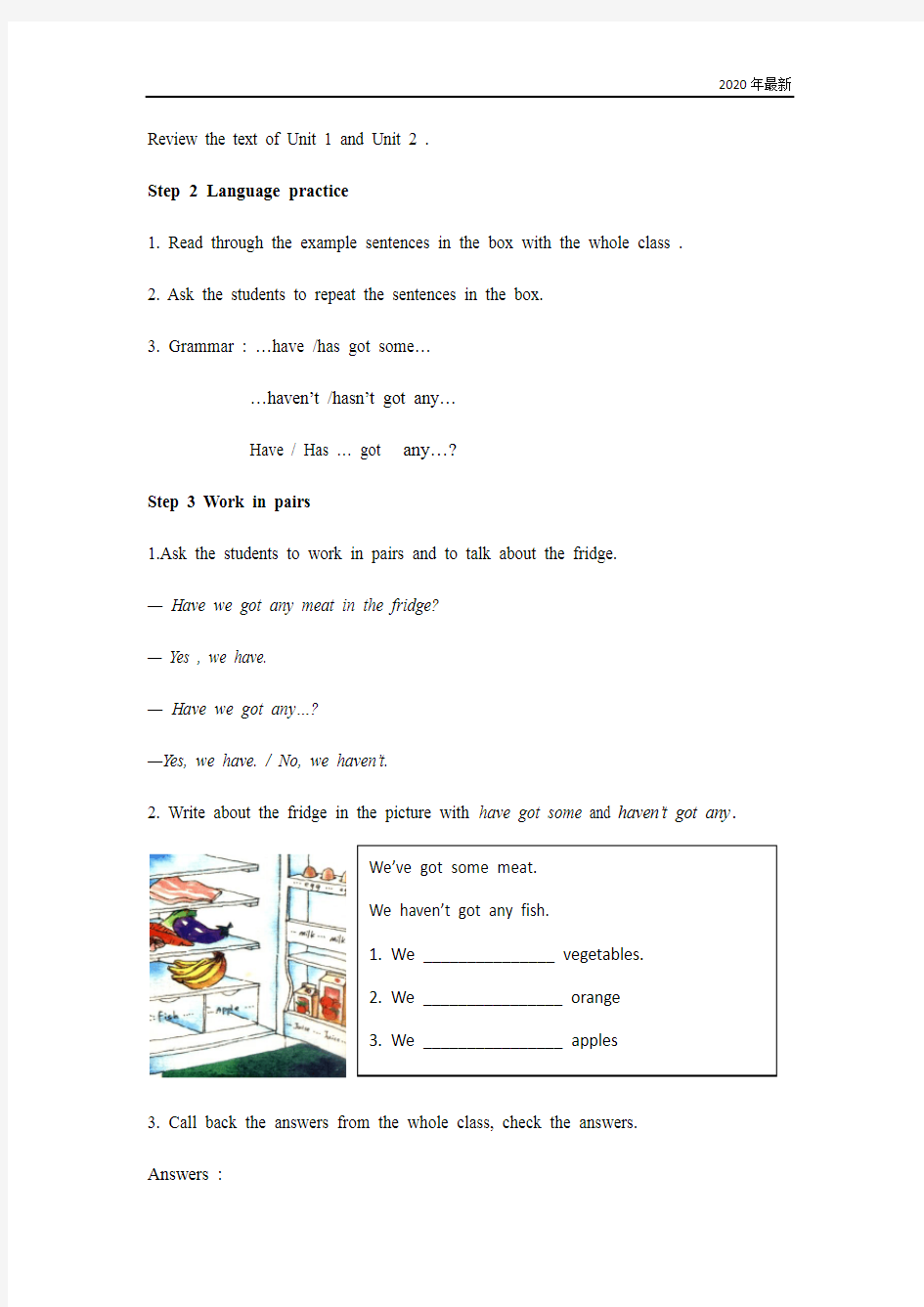外研版七年级英语上册Module 4 Unit 3教案


Module 4 Healthy food
Unit 3 Language in use
教学目标
【知识与技能】
1. 掌握本模块的单词和短语
2. 熟练运用have/has got句型。
3. 能在句子中正确使用some, any。
4. 正确区分可数名词与不可数名词,并能正确使用可数名词的复数形式。
5. 能够运用所学的知识发表自己对食品的看法,在同学之间进行真实的交际。【情感、态度与价值观】
让学生学会区分健康食品与垃圾食品,培养学生形成良好的饮食习惯,拥有强健的体魄。
教学重难点
【教学重点】
1. 能够运用所学的知识发表自己对食品的看法。
2. 能够制作食品海报并进行展示。
【教学难点】
1. 能够运用所学的知识发表自己对食品的看法。
2. 能够制作食品海报并进行展示。
教学过程
Step 1 Revision
Review the text of Unit 1 and Unit 2 .
Step 2 Language practice
1. Read through the example sentences in the box with the whole class .
2. Ask the students to repeat the sentences in the box.
3. Grammar : …have /has got some…
…haven’t /hasn’t got any…
Have / Has … got any…?
Step 3 Work in pairs
1.Ask the students to work in pairs and to talk about the fridge.
— Have we got any meat in the fridge?
— Yes , we have.
— Have we got any…?
—Yes, we have. / No, we haven’t.
2. Write about the fridge in the picture with have got some and haven’t got any .
3. Call back the answers from the whole class, check the answers.
Answers :
1. have got some
2. haven’t got any
3. haven’t got any
4. have got some
5. have got some
6. have got some
7. haven’t got any
Step 4 Look at the picture in Activity 2 and talk about it.
1. Ask the students to read the words in the box.
2. Look at the picture carefully.
3. Talk about like this:
He has got some a(n)…
He hasn’t got any…
She has got some a(n)…
She hasn’t got any…
They have got some a(n)…
They haven’t got any…
Step 5 Complete the word map.
1. Ask the students to complete the word map individually, then check with a partner.
2. Call back the answers from the whole class, check the answers.
Step 6 Complete the sentences with the words from the box.
1. Ask the students to read through the sentences.
2. Complete the sentences with the words from the box.
3. Ask the students to check with a partner.
4. Call back the answers from the whole class.
Keys:1. Remember 2. important 3. stay 4. delicious 5. bit
Step 7 Grammar.
名词的复数
A) 构成方法及读音规则
1) 一般情况加–s:map-maps boy-boys girl-girls pen-pens bag-bags car-cars
清辅音后读/s/ 浊辅音和元音后读/z/
2) 以s, sh, ch, x等结尾加–es, 读/iz/
bus-buses watch-watches box-boxes brush-brushes
3) 以辅音字母+y结尾,变y 为i再加es, 读/z/
baby---babies city-cities country-countries
但以y结尾的专有名词,或元音字母+y 结尾的名词变复数时,直接加s变复数。例如:two Marys the Henrys monkey---monkeys holiday---holidays
4) 以o结尾的名词,变复数时:
a. 加s,如:photo— photos piano—pianos
radio—radios zoo—zoos;
b. 加es,如:potato— potatoes tomato—tomatoes
5)以f或fe 结尾的名词变复数时:改f, fe 加ves,如:half—halves knife—knives leaf—leaves wolf—wolves
wife—wives life—lives thief—thieves;
B) 名词复数的不规则变化
1) child—children , foot—feet, tooth—teeth mouse—mice,man—-men ,woman—women
注意:由一个词加man 或woman构成的合成词,其复数形式也是-men 和-women,如an Englishman,two Englishmen。但German不是合成词,故复数形式为Germans;Bowman是姓,其复数是the Bowmans。
2)单复同形,如deer,sheep,fish,Chinese,Japanese ,li,jin,yuan,two li,three mu,four jin等。但除人民币的元、角、分外,美元、英镑、法郎等都有复数形式。如:a dollar, two dollars; a meter, two meters。
3)集体名词,以单数形式出现,但实为复数。例如:
people police cattle 等本身就是复数,不能说a people,a police,a cattle,但可以说a person,a policeman,a head of cattle.
4)以s结尾,仍为单数的名词,如:
a. maths,politics,physics等学科名词,一般是不可数名词,为单数。
b. news 为不可数名词。
c. the United States,the United Nations 应视为单数。
The United Nations was organized in 1945. 联合国是1945年组建起来的。
5)表示由两部分构成的东西,如:glasses (眼镜)trousers,clothes等,若表达具体数目,要借助数量词pair(对,双);suit(套); a pair of glasses; two pairs of trousers等。
6)另外还有一些名词,其复数形式有时可表示特别意思,如:goods货物,waters 水域,fishes(各种)鱼。
C) 不可数名词:不可数名词主要分物质名词和抽象名词。
1) 物质名词是指表示无法分为个体的实物的词,常见的物质名词,如:snow(雪),rain(雨), water(水),coffee(咖啡), tea(茶), meat (肉), milk(牛奶), rice(米饭), bread(面包), orange (桔汁), beef (牛肉), chicken(鸡肉) , juice (果汁), pork(猪肉) , Coke (可口可乐), ice cream (冰激凌) 等;
2) 抽象名词是指表示动作、状态、品质、感情等抽象概念的词,常见的抽象名词,如:work(工作), study(学习), love(爱), friendship (友谊)等。
Step 8 Around the world : A Western breakfast.
1. Ask the students to look at the picture and discuss what they can see.
2. Read through the information with the whole class.
Step 9 Module task: Making a poster about a healthy breakfast.
1.Work in groups of four or five. Make a poster about a healthy breakfast.
2. Present your poster to the class. Talk about it with your classmates.
Homework
Write a passage to introduce your eating habits.
教学反思
